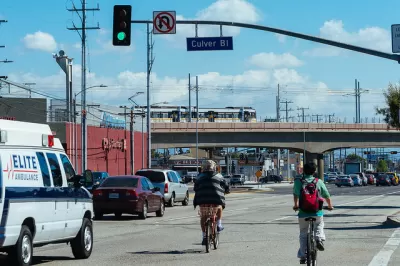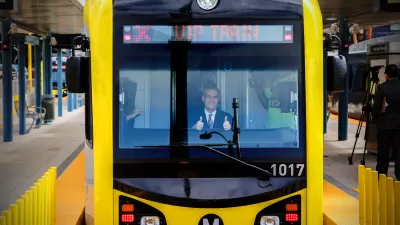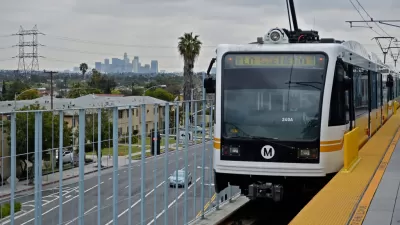Facing explosive development interest around its Metro station, the small city of Culver on L.A.’s Westside is taking steps to shape its mobility future.

Over the next four years, the five-square-mile city of Culver is expecting ten new developments focused around its Metro Expo Line station to bring 30,000 new daily trips to its streets. In anticipation of those impacts, the Los Angeles-area city has elected to craft, not just a congestion management plan, but a comprehensive vision for mobility and growth that will eventually fold into a general plan update. In The Planning Report, Culver City Vice Mayor Thomas Small and consultant Craig Nelson unpack the Transit Oriented Development Visioning Plan.
Small explains:
Our solution in Culver City is not to try to stop development, but to work with it, and to create a multimodal mobility system that will enable all these people to get around. We need a mobility system that will work with development.
Culver is just one small piece of a patchwork of more than 30 transit networks in Los Angeles County. To create a "complete journey" for riders, the plan will have to find a way to make the transition between infrastructure systems feel seamless.
Creating an easy, comfortable experience is a core component of the plan, which relies heavily on detailed community outreach. That's important in part because transit ridership is falling throughout L.A. County as well as nationwide. Nelson explains:
I’m striving to help transit agencies in the US think beyond a new app, a new website, or new sensors across the network. You need to speak to your users. You need to understand why they don’t use the bus—why it’s uncomfortable for them to use the bus—and think about how good design, good strategy, and good policy can be used to deliver a more accessible and better-to-use transit network.
FULL STORY: Culver City Hosts Mobility Visioning Process Involving Stakeholders, Architects & Planners

Study: Maui’s Plan to Convert Vacation Rentals to Long-Term Housing Could Cause Nearly $1 Billion Economic Loss
The plan would reduce visitor accommodation by 25,% resulting in 1,900 jobs lost.

North Texas Transit Leaders Tout Benefits of TOD for Growing Region
At a summit focused on transit-oriented development, policymakers discussed how North Texas’ expanded light rail system can serve as a tool for economic growth.

Why Should We Subsidize Public Transportation?
Many public transit agencies face financial stress due to rising costs, declining fare revenue, and declining subsidies. Transit advocates must provide a strong business case for increasing public transit funding.

How to Make US Trains Faster
Changes to boarding platforms and a switch to electric trains could improve U.S. passenger rail service without the added cost of high-speed rail.

Columbia’s Revitalized ‘Loop’ Is a Hub for Local Entrepreneurs
A focus on small businesses is helping a commercial corridor in Columbia, Missouri thrive.

Invasive Insect Threatens Minnesota’s Ash Forests
The Emerald Ash Borer is a rapidly spreading invasive pest threatening Minnesota’s ash trees, and homeowners are encouraged to plant diverse replacement species, avoid moving ash firewood, and monitor for signs of infestation.
Urban Design for Planners 1: Software Tools
This six-course series explores essential urban design concepts using open source software and equips planners with the tools they need to participate fully in the urban design process.
Planning for Universal Design
Learn the tools for implementing Universal Design in planning regulations.
Ascent Environmental
Borough of Carlisle
Institute for Housing and Urban Development Studies (IHS)
City of Grandview
Harvard GSD Executive Education
Toledo-Lucas County Plan Commissions
Salt Lake City
NYU Wagner Graduate School of Public Service




























